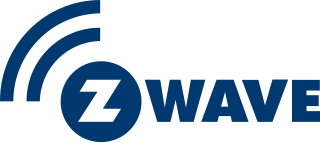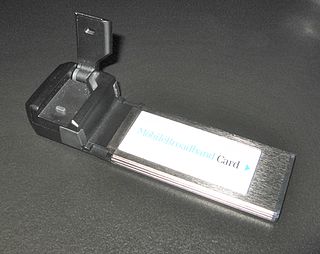
Wireless Markup Language (WML), based on XML, is an obsolete markup language intended for devices that implement the Wireless Application Protocol (WAP) specification, such as mobile phones. It provides navigational support, data input, hyperlinks, text and image presentation, and forms, much like HTML. It preceded the use of other markup languages used with WAP, such as XHTML and HTML itself, which achieved dominance as processing power in mobile devices increased.

The International Mobile Equipment Identity (IMEI) is a numeric identifier, usually unique, for 3GPP and iDEN mobile phones, as well as some satellite phones. It is usually found printed inside the battery compartment of the phone but can also be displayed on-screen on most phones by entering the MMI Supplementary Service code *#06# on the dialpad, or alongside other system information in the settings menu on smartphone operating systems.

Worldwide Interoperability for Microwave Access (WiMAX) is a family of wireless broadband communication standards based on the IEEE 802.16 set of standards, which provide physical layer (PHY) and media access control (MAC) options.
BACnet is a communication protocol for building automation and control (BAC) networks that use the ASHRAE, ANSI, and ISO 16484-5 standards protocol.

The Wi-Fi Alliance is a non-profit organization that owns the Wi-Fi trademark. Manufacturers may use the trademark to brand products certified for Wi-Fi interoperability. It is based in Austin, Texas.

IEEE 802.16 is a series of wireless broadband standards written by the Institute of Electrical and Electronics Engineers (IEEE). The IEEE Standards Board established a working group in 1999 to develop standards for broadband for wireless metropolitan area networks. The Workgroup is a unit of the IEEE 802 local area network and metropolitan area network standards committee.
OMA SpecWorks, previously the Open Mobile Alliance (OMA), is a standards organization which develops open, international technical standards for the mobile phone industry. It is a nonprofit Non-governmental organization (NGO), not a formal government-sponsored standards organization as is the International Telecommunication Union (ITU): a forum for industry stakeholders to agree on common specifications for products and services.
The Global Certification Forum, known as GCF, is an London-based partnership between mobile network operators, mobile device manufacturers and the test industry. GCF was founded in 1999, and its membership has been responsible for creating an independent certification programme to help ensure global interoperability between mobile devices and networks.
DigitalLiving Network Alliance (DLNA) is a set of interoperability standards for sharing home digital media among multimedia devices. It allows users to share or stream stored media files to various certified devices on the same network like PCs, smartphones, TV sets, game consoles, stereo systems, and NASs. DLNA incorporates several existing public standards, including Universal Plug and Play (UPnP) for media management and device discovery and control, wired and wireless networking standards, and widely used digital media formats. Many routers and network attached storage (NAS) devices have built-in DLNA support, as well as software applications like Windows Media Player.

The history of mobile phones covers mobile communication devices that connect wirelessly to the public switched telephone network.

Z-Wave is a wireless communications protocol used primarily for residential and commercial building automation. It is a mesh network using low-energy radio waves to communicate from device to device, allowing for wireless control of smart home devices, such as smart lights, security systems, thermostats, sensors, smart door locks, and garage door openers. The Z-Wave brand and technology are owned by Silicon Labs. Over 300 companies involved in this technology are gathered within the Z-Wave Alliance.

Mobile broadband is the marketing term for wireless Internet access via mobile (cell) networks. Access to the network can be made through a portable modem, wireless modem, or a tablet/smartphone or other mobile device. The first wireless Internet access became available in 1991 as part of the second generation (2G) of mobile phone technology. Higher speeds became available in 2001 and 2006 as part of the third (3G) and fourth (4G) generations. In 2011, 90% of the world's population lived in areas with 2G coverage, while 45% lived in areas with 2G and 3G coverage. Mobile broadband uses the spectrum of 225 MHz to 3700 MHz.
A Central Equipment Identity Register (CEIR) is a database of mobile equipment identifiers. Such an identifier is assigned to each SIM slot of the mobile device.
CDMA Certification Forum was the original official authority governing CDMA Device certification. The CCF was an international partnership between network operator and device vendors to maintain and evolve a core global device certification process that helps improve quality through consistent interoperability, conformance and performance testing across the globe. On 31 December 2014, CCF voted to hand all its certification responsibilities to the Global Certification Forum (GCF).
MIPI Alliance is a global business alliance that develops technical specifications for the mobile ecosystem, particularly smart phones but including mobile-influenced industries. MIPI was founded in 2003 by Arm, Intel, Nokia, Samsung, STMicroelectronics and Texas Instruments.

Universal charger or common charger refers to various projects to standardize the connectors of power supplies, particularly for battery-powered devices.
The GSM Association is a non-profit industry organisation that represents the interests of mobile network operators worldwide. More than 750 mobile operators are full GSMA members and a further 400 companies in the broader mobile ecosystem are associate members.
Linaro is an engineering organization that works on free and open-source software such as the Linux kernel, the GNU Compiler Collection (GCC), QEMU, power management, graphics and multimedia interfaces for the ARM family of instruction sets and implementations thereof as well as for the Heterogeneous System Architecture (HSA). The company provides a collaborative engineering forum for companies to share engineering resources and funding to solve common problems on ARM software. In addition to Linaro's collaborative engineering forum, Linaro also works with companies on a one-to-one basis through its Services division.
Sony Semiconductor Israel Ltd., formerly known as Altair Semiconductor, is an Israeli developer of high performance single-mode Long Term Evolution (LTE) chipsets. The company's product portfolio includes baseband processors, RF transceivers and a range of reference hardware products. Founded in 2005, Altair employs 190 employees in its Hod Hasharon, Israel headquarters and R&D center, and has regional offices in the United States, Japan, China, India, Finland, and France. Altair Semiconductor was the first chipset vendor to receive certification from Verizon Wireless to run on its 4G LTE network. Altair has also powered several devices launched on Verizon's network including the Ellipsis 7 tablet and HP Chromebook 11.6"LTE. In January 2016, it was announced that Sony was acquiring Altair for $212 Million. Altair was renamed Sony Semiconductor Israel on March 29, 2020.
Citizens Broadband Radio Service (CBRS) is a 150 MHz wide broadcast band of the 3.5 GHz band in the United States. In 2017, the US Federal Communications Commission (FCC) completed a process which began in 2012 to establish rules for commercial use of this band, while reserving parts of the band for the US Federal Government to limit interference with US Navy radar systems and aircraft communications.









